




MapCode :
154 505 105*08
Phone :
084-523-7911
Website :
Address :
269 Setodachō Setoda, Onomichi, Hiroshima 722-2411
0.9
km / 0.6
miles
-
(3
minutes)






Min/Max Time :
10 / 20
Minutes
MapCode :
154 506 274*77
Phone :
084-527-3800
Website :
Description :
Ikuo Hirayama is the most celebrated contemporary artist working in the genre of Nihon-ga,or traditional Japanese painting, and his works on the Silk Road and on mankind’s outstanding cultural monuments have made his name well-known far beyond his native shores.
Born on this small island in the Inland Sea, Hirayama’s childhood years were almost idyllic, until the outbreak of World War II brought him face-to-face with a grimmer reality. While still a schoolboy, he was called up in 1945 to work at an ammunition depot in Hiroshima, and he narrowly escaped death when the atomic bomb was dropped. The after effects of the radiation sickness he suffered were to plague him throughout his early career.
It was this struggle with ill-health that led him to depict Buddhist themes in his painting, and these works not only brought him much public acclaim but also sparked his interest in the Silk Road and the ancient civilizations found there. Thus, from the mid-1960s, Hirayama began almost annual pilgrimages to sites along the entire length of the Silk Road, from Turkey to the remote desert regions of China, sketching the people and scenes he encountered.
On these visits he was saddened by the state of disrepair of many of the ancient monuments, and this fired his determination to help restore and preserve these treasures of civilization. Despite the heavy demands of his official position as the president of the Tokyo National University of Fine Arts and Music, he worked tirelessly for this cause, setting up organizations to save such sites as the Thousand Buddha Caves at Dunhuang, China, and the Buddhist complex at Angkor, Cambodia, even donating the money from sales of his paintings. His contributions in this field and to international cultural exchange in general have been recognized by several governments.
He held prominent positions such as UNESCO Goodwill Ambassador, special adviser for cultural heritage, special appointed director of Tokyo National Museum, administrative director of a foundation for cultural heritage and art research, and administrative director of the Japan Art Academy Exhibition.
He died December 2, 2009 at the age of 79.
Born on this small island in the Inland Sea, Hirayama’s childhood years were almost idyllic, until the outbreak of World War II brought him face-to-face with a grimmer reality. While still a schoolboy, he was called up in 1945 to work at an ammunition depot in Hiroshima, and he narrowly escaped death when the atomic bomb was dropped. The after effects of the radiation sickness he suffered were to plague him throughout his early career.
It was this struggle with ill-health that led him to depict Buddhist themes in his painting, and these works not only brought him much public acclaim but also sparked his interest in the Silk Road and the ancient civilizations found there. Thus, from the mid-1960s, Hirayama began almost annual pilgrimages to sites along the entire length of the Silk Road, from Turkey to the remote desert regions of China, sketching the people and scenes he encountered.
On these visits he was saddened by the state of disrepair of many of the ancient monuments, and this fired his determination to help restore and preserve these treasures of civilization. Despite the heavy demands of his official position as the president of the Tokyo National University of Fine Arts and Music, he worked tirelessly for this cause, setting up organizations to save such sites as the Thousand Buddha Caves at Dunhuang, China, and the Buddhist complex at Angkor, Cambodia, even donating the money from sales of his paintings. His contributions in this field and to international cultural exchange in general have been recognized by several governments.
He held prominent positions such as UNESCO Goodwill Ambassador, special adviser for cultural heritage, special appointed director of Tokyo National Museum, administrative director of a foundation for cultural heritage and art research, and administrative director of the Japan Art Academy Exhibition.
He died December 2, 2009 at the age of 79.
Hours :
Open daily 09:00 – 17:00
Address :
200-2 Setodachōsawa, Onomichi, Hiroshima 722-2413
0.3
km / 0.2
miles
-
(2
minutes)





Min/Max Time :
10 / 30
Minutes
MapCode :
154 506 125*66
Phone :
084-527-0800
Website :
Description :
The Kosanji Temple is a temple belonging to the Honganji Sect of the Jodo Shinshu School of Pure Land Buddhism. It was founded in 1936 by the industrialist Kozo Kosanji as a family temple dedicated to his mother. The temple complex was constructed over a period of more than 30 years. Kosanji not only built the temple, but even entered the priesthood in order to repay a son’s debt of gratitude to his mother.
The complex consists of over 20 buildings, a statue of Kuse Kannon, the superb Choseikaku Villa where his mother lived, the Kongo Gallery, and access to the Hill of Hope marble garden.
Public parking at MapCode: 154 506 279*74
Courtesy of www.kousanji.or.jp
The complex consists of over 20 buildings, a statue of Kuse Kannon, the superb Choseikaku Villa where his mother lived, the Kongo Gallery, and access to the Hill of Hope marble garden.
Public parking at MapCode: 154 506 279*74
Courtesy of www.kousanji.or.jp
Hours :
Open daily 09:00 – 17:00
Address :
553-2 Setodachō Setoda, Onomichi, Hiroshima 722-2411
0.2
km / 0.1
miles
-
(1
minutes)
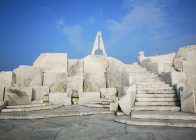
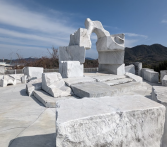
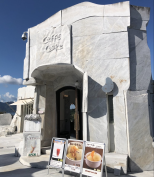
Min/Max Time :
10 / 20
Minutes
MapCode :
154 475 899*34
Phone :
084-527-0800
Description :
The Hill of Hope, Miraisinnooka, is a 5,000 square meter white marble garden by world famous Japanese sculptor Itto Kuetani. It took over 16 years to construct. The marble is all from Carrara, Italy.
The garden is accessible through the Kaujanji Temple complex next door. Public parking at MapCode: 154 506 279*74
Courtesy of www.kousanji.or.jp
The garden is accessible through the Kaujanji Temple complex next door. Public parking at MapCode: 154 506 279*74
Courtesy of www.kousanji.or.jp
Hours :
Open daily 09:00 – 17:00
Address :
553-2 Setodachō Setoda, Onomichi, Hiroshima 722-2411
4.0
km / 2.5
miles
-
(7
minutes)
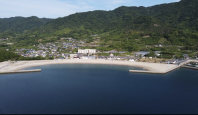

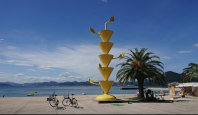
Min/Max Time :
10 / 60
Minutes
MapCode :
154 414 184*47
Phone :
084-527-1100
Website :
Description :
The 800 m/2,625 ft long white sand Setoda Sunset Beach (also called Shimanami Lemon Beach) is credited as one of the top 100 beaches in Japan. It has toilets, changing rooms, and showers available.
The restaurant Windtime / ウインドタイム is open from 09:00-16:00 daily (closed on Tuesdays), serving lunch until 15:00, only drinks thereafter.
The store is open from 09:00 to 17:00 daily selling local products as well as swim related items.
The Shimanami Rental Cycle Terminal / しまなみレンタサイクルターミナル (including electric assist ones) is open from 09:00 - 17:00 for JPY3,300/bike (no drop-offs allowed; return during business hours).
Sea kayaks are also available for rent.
The beach also features the artwork of various artists.
The restaurant Windtime / ウインドタイム is open from 09:00-16:00 daily (closed on Tuesdays), serving lunch until 15:00, only drinks thereafter.
The store is open from 09:00 to 17:00 daily selling local products as well as swim related items.
The Shimanami Rental Cycle Terminal / しまなみレンタサイクルターミナル (including electric assist ones) is open from 09:00 - 17:00 for JPY3,300/bike (no drop-offs allowed; return during business hours).
Sea kayaks are also available for rent.
The beach also features the artwork of various artists.
Hours :
Beach open daily 09:00 – 17:00. Restaurant open 09:00 - 16:00 daily, closed on Tuesdays.
Address :
1506-15 Setodachō Tarumi, Onomichi, Hiroshima 722-2404
9.4
km / 5.8
miles
-
(12
minutes)
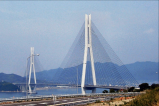
Min/Max Time :
5 / 15
Minutes
MapCode :
154 323 690*00
Phone :
078-291-1033
Description :
The Tatara Bridge is a cable-stayed bridge that is part of the Nishiseto Expressway, commonly known as the Shimanami Kaidō. The bridge has a center span of 890 m / 2,920 ft. As of 2010 it has the fourth longest main span of any cable-stayed bridge after the Sutong Bridge in China. The expressway is a series of roads and bridges that is one of the three routes of the Honshū-Shikoku Bridge Project connecting the islands of Honshū and Shikoku across the Seto Inland Sea in Japan. The bridge, which opened on May 1, 1999, carries two lanes of traffic in each direction and has additional lanes for bicycles, motor bikes, and pedestrians.
Courtesy of Wikipedia
Courtesy of Wikipedia
Hours :
Open daily 24/7
Address :
Setodachoogi, Onomichi, Hiroshima 722-2403
2.8
km / 1.7
miles
-
(4
minutes)

Min/Max Time :
10 / 20
Minutes
MapCode :
154 321 113*74
Phone :
089-787-3866
Hours :
Open daily 10:00 – 16:00
Address :
9180-2 Kamiurachō Inokuchi, Imabari, Ehime 794-1402, Japan
8.0
km / 5.0
miles
-
(12
minutes)

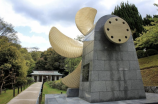
Min/Max Time :
10 / 30
Minutes
MapCode :
154 285 325*87
Phone :
089-782-0032
Hours :
Open daily 09:00 – 15:30
Address :
3327 Ōmishimachō Miyaura, Imabari, Ehime 794-1304
11.7
km / 7.3
miles
-
(15
minutes)
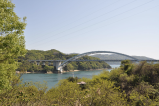
Min/Max Time :
5 / 10
Minutes
MapCode :
154 172 452*50
Description :
The Omishima Bridge crosses Hanaguri Seto between Omishima Island and Hakata Island. This bridge is the only arch bridge crossing the Seto Inland Sea. This Bridge was the first bridge completed as part of the Honshu-Shikoku Bridges project.
The arch length of the bridge was the longest one in Japan at that time. The color, light gray, of painting, materials and construction method of pavement, etc. of the Bridge were applied for other bridges in the Honshu-Shikoku Bridges.
i>Courtesy of Honshu-Shikoku Bridge Expressway Company Ltd.
The arch length of the bridge was the longest one in Japan at that time. The color, light gray, of painting, materials and construction method of pavement, etc. of the Bridge were applied for other bridges in the Honshu-Shikoku Bridges.
i>Courtesy of Honshu-Shikoku Bridge Expressway Company Ltd.
Hours :
Open daily 24/7
Address :
Hakatacho Ikata, Imabari, Ehime 794-2303